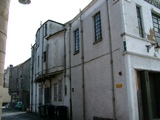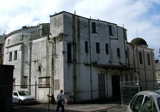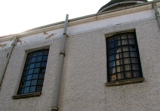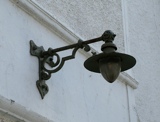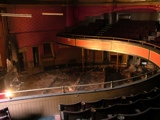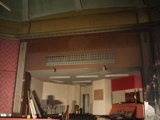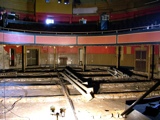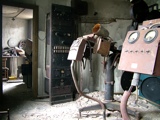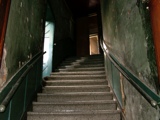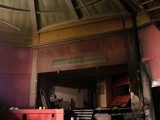Hope Street

Exterior picture courtesy of Graham Kelly
Contstructed on a corner site, the Hippodrome consisted of a circular auditorium with wrap-around gallery facing a proscenium and small stage. What little ancillary space was wrapped around this, filling in the corners of the site. The Oct 1911 plans even show that at this stage, the lavatories were 'to be built later'! The flat roof was supported on three girders, running parallel to the screen. Two entrances with separate payboxes led in from Hope Street - one to the front stalls, one to the rear, where a stair accessed the balcony. The stalls were shown as seating 510, and the balcony 215 - although it seems as if the line of the balcony front may have been altered at a late stage. The balcony was supported on cast-iron pillars. A folding metal stair served as a fire escape for the balcony, and a dedicated (but tiny) Operators Box was at the rear of the gallery. The resulting cinema was a very large and impressive (and presumably risky) investment for the time, but clearly was quickly a success. In March 1926 plans were lodged - again by Mathew Steel - to quite literaly raise the roof, replacing the original flat ceiling with a pitched replacement, the blueprints for the steelwork of which were drawn up by the Fleming Bros company of Glasgow. At some point after this but before 1930, a second stairway was constructed to give an additional exit from the back of the balcony, and the projection room was also expanded somewhat.
In March 1930 futher alterations took place, when permission was saught to insert a fire exit door at the centre rear of the stalls. Then in June of that year, the balcony front was realigned to improve sightlines - these plans were by architect John Taylor. Around 1936(?), the manager gained a new, large office when an additional floor was constructed over the tiny entrance, allowing what had been the office on the ground floor to add to the foyer space. This was topped by a new dome on the corner. The new, enlarged entrace foyer was decorated with panelling rescued from a ship, which had been broken up locally. By 1947, the Hippodrome was being run by Caledonian Associated Cinemas, who employed their house architect - Alex Cattenach of Kingussie - to bring the facilities at the cinema up to date. The separate front stalls entrance was blocked up, and a new ladies toilet formed from the space. Other toilets were refurbished, and the seating respaced and realigned. The main alteration involved enlarging the projection facilities, with a new larger box that slightly overhung the back of the balcony, and featured a new tight winding staircase to it, and a steel escape ladder from the booth. The orchestra pit was also removed and floored over at this point.
The Hippodrome continued as a cinema until the 1970s, when it went over to bingo. Despite a few alterations, such as the installation of a bar on the stage, and the re-opening of a secondary entrance, the interior remained largely unaltered. Bingo closed around 1980, and the building has remained empty ever since, with the projectors intact and decaying slowly in situ - these are Kalee 12, with BTH soundheads and a BTH EFR amplifier with Peerless Magnarcs arc lamps. Numerous plans have been mooted over the years to rehabilitate the site, but finally funding, political will and enthusiasm have come together in a plan to reopen the building as a community cinema and venue, with work commenced in Autumn 2006. Funding is in part thanks to a Townscape Heritage lottery initiative. Some photos from during the refurbishment process can be seen here, thanks to Dorothy McCallum. In February 2008, the keys of the building were officially handed over to Falkirk Council, and the cinema will re-open sometime in the next few months.
The site was A-listed by Historic Scotland in 1979, and has been on the Buildings at Risk register since 1994.
Many thanks for Pete Reid and Gareth Jones, and the members of the Scottish Historic Buildings Trust for allowing us access and being such welcoming and enthusiastic hosts. Photos below of the surviving extant interior equipment
courtesy
of Pete Naples
References Theatres Trust Guide to British Theatres, Earl & Sell, 2000 Scotland's Splendid Theatres, Peter, 1999 BBC News article on the Hippodrome redevelopment |




